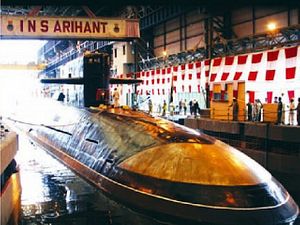Nearly a year ago last February, the Indian Navy’s chief of staff, Admiral D.K. Joshi, resigned in disgrace after two officers died in a fire on the INS Sindhuratna, an aging diesel-electric submarine, stationed just off the coast of Mumbai. The deaths and Joshi’s dramatic retirement seemed to sound the alarm that an upgrade for Delhi’s atrophied undersea force was sorely needed.
Little has improved in the past year, even as China has boosted its presence in the Indian Ocean region. A new ballistic missile sub, the INS Arihant, has only just begun sea trials. Delhi remains on the hunt for new diesel-electric subs to replace the sidelined Sindhuratna. Six Scorpene-class diesel-electric “hunter killer” vessels, built under a technology transfer program with France, were supposed to be ready for trials, but are still undergoing extensive refurbishment. That project has been ongoing since 2007. Without those subs, along with Shishumar- and Sindhughash-class vessels, set to be outfitted with tube-launched Harpoon missiles, India will have to tough it out for the next several months with a weakened underwater defensive perimeter. India recently sought to purchase Japanese-manufactured Soryu-class submarines, but it’s unclear if that deal will move forward.
India is trying to mitigate that disadvantage elsewhere. Under the oversight of Defense Minister Manohar Parrikar, India’s defense budget rose by 12 percent last year, to $38.35 billion. Increasing the cap for foreign direct investment in the defense sector, from 26 to 49 percent of spending, has given Delhi much more leeway in building indigenous equipment. The Navy gets about one-fifth of that pie, and as one of the best managed services in the military, it spends heavily on modernization. On a whole, however, defense spending is just 1.5 percent of GDP. India also lacks a cogent defense plan, which Parrikar blames on a history of mismanagement at the ministry.
India’s manufacturing sector is also improving. Mazagon Dock, Garden Reach, and Cochin Shipyard are working full tilt, if not yet to capacity. With Washington’s support, India is poised to boost defense indigenization efforts in 2015. The politics in the region are also tilting in Delhi’s favor, particularly after Maithripala Sirisena knocked out the two-term incumbent, Mahinda Rajapaksa, in Sri Lanka’s elections a month ago. Rajapaksa had encouraged Chinese port calls to Colombo.
If India is to realize the potential of its undersea forces, the navy can’t afford any more costly mistakes.
































